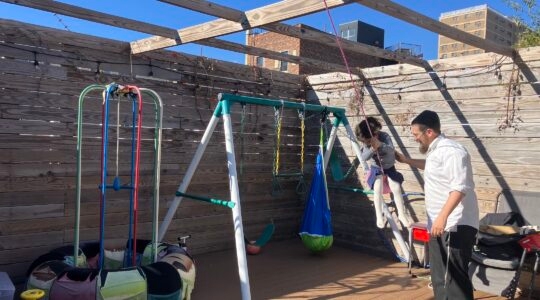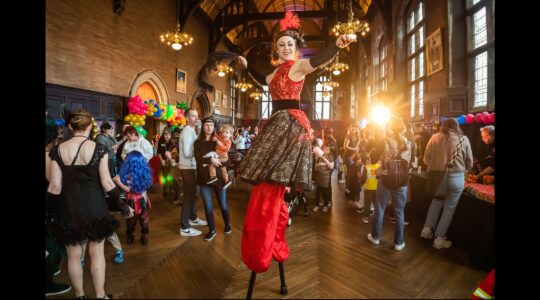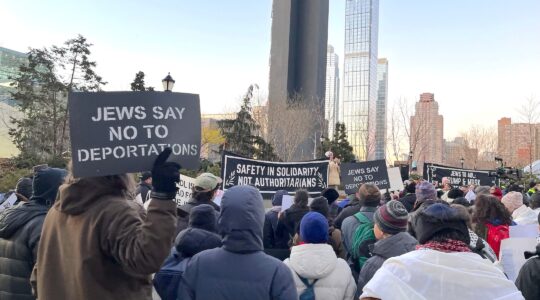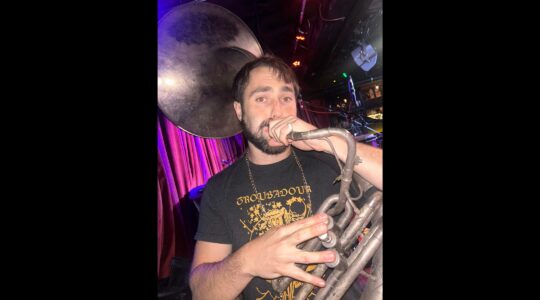The hurricane was called Sandy but Af-Bri is the “Angel of the Rains.”
On Oct. 8, Shemini Atzeret, exactly three weeks before “Frankenstorm,” the Jews of Brooklyn’s Sea Gate (and around the world) said the annual “Prayer for Rain,” calling on Af-Bri to “thicken and form clouds and empty them,” perhaps with anger (Af), preferably for a blessing, for health (Bri), with the seasonal insert of Mashiv HaRuach, “He makes the wind blow and the rain…”
On Oct. 29 came the rains and the winds, with a violent “anger” such as the Atlantic coast rarely, if ever, experienced. A Satmar chasid in Sea Gate, who asked for anonymity, says, “Everyone here is wiped out or washed out. Sea Gate had four mikvehs,” the ritual pools. “Now everyone has a mikveh in their basement.”
Just days later came the “Bri,” the healing, the blessing, on Facebook, of all places. A post-high school, pre-army program for Israelis, “Ein Prat – Israel’s Leadership Academy,” put out the word that Jews in the hurricane’s ruins needed help. Could any alumni be available to get on a plane, almost immediately, and fly to New York? Twelve young men and women, able to leave on a moment’s notice, answered yes, and packed their bags.
It was Lynne Galler’s idea. An Upper West Sider resident, Galler serves on the Ein Prat board and teaches there, as well, on issues of Jewish identity and connection.
“A few years ago,” she recalls, there was a conversation at Ein Prat “about the widening gap between Israeli and American Jews. I said to them, ‘You think that I, as a rich American Jew, have a responsibility to you. Do you have a responsibility to me, as a Jew in the diaspora?’ They looked at me, like, ‘what is she talking about?’ But now, when I asked them to come, they came.
“We needed housing [everyone was put up in apartments], we needed financial support on the ground — and we were helped by UJA-Federation [of New York] — and we needed to pay for the tickets, which we did,” says Galler, noting that the group received contributions and support from friends, many from her shul, Congregation Or Zarua on the Upper East Side.
The 12 from Ein Prat, ages 22-31, landed in New York on Nov. 7, going to work every day but Shabbat with the Jewish Association Servicing the Aging (JASA) in Far Rockaway, Queens, and then moving on to Sea Gate where, says Galler, “the need is dire, working under horrible conditions.”
Sea Gate, a gated community just to the west of Coney Island, was a gentle place just weeks ago. In the summer, one could see fireworks over the water, and a lighthouse from the 1800s stood as a sentry near rocks lapped by the waves. The avenues in the vicinity are Surf, Mermaid and Neptune, the crossroads of a summer fantasy. A sign at the community’s gate reads: “Welcome to Sea Gate – A Safe Place to Live and Visit.”
No doubt it was, but now, from Sea Gate to Coney Island, people in trouble are lining up for hot food and clothing from Red Cross trucks and relief organizations. Broken furniture and debris sit in piles at the sidewalk’s edge.
And on Maple Avenue, within Sea Gate, the Ein Prat volunteers, in a basement that recently held six feet of water, are prying apart wooden floors and walls, pulling out the molding wood, the insulation, fiberglass and asbestos. The young Israelis are wearing sweatshirts, industrial boots and gloves, paper masks over their mouths, so one can’t quite see their faces but only their blue, brown and hazel eyes, the dark complexions, the freckles on high cheekbones. They pass the basement’s rubble, by hand or in pails, one to another, like an old fire brigade, through a broken window. Sometimes the middle-aged Satmar chasid, beefy and bearded, wearing his frock coat and chasidic elegance, works alongside the young Israelis. It’s good that you are here, the chasid says to them, instead of in a war or under rockets.
Ein Prat is a co-ed school with about 50 students, rich and poor, religious and secular. They study Torah, Talmud and Zionist texts. “We train them,” says Galler, “to be people who’ll take responsibility for the problems that they see around them and create solutions.” The rest of the time is spent volunteering, and on intense physical activity, such as desert survival, preparing to be soldiers.
Here they were, sweating through their shirts despite the crisp November air, working from morning into the dusk, because they loved the Jew who once lived there, even if they didn’t know him or her. The Ein Prat volunteers acted less like a demolition crew than like a chevra kadisha (burial society), treating what was destroyed with a holy dignity, seeing it as a privilege.
Amir Tal, 25, from Kibbutz Haon near the banks of the Kinneret, wearing a stained Superman T-shirt, put down a shovel. “There is no good thing or bad thing to save — everything goes into the trash.” A siddur [prayerbook] and chumash [Five Books of Moses], soaked, needed to be buried. Tal stopped to look at what must have been the photographs of the people who once lived there — trips to Mexico City, Guatemala and a place “that looked like Israel.”
A few blocks away was an 18-foot trailer, loaded with soaking holy books that require burial. It wasn’t so much “the geshem [the rain],” says the Satmar. “It wasn’t the water coming down but the water rising up from the ocean. This was not geshem, this was a mabul,” a flood, with the word evoking a biblical deluge, along with a message, but who could read between the waves?
“We don’t know when it’s going to end and we don’t know what’s coming tomorrow,” says the chasid. “But we see the tremendous chesed [kindness] that people are doing. Hashem is going to see all of this and this will bring a lot of merit to all of us. Whoever comes,” says the chasid, as he looked at the Israelis, “they should all be blessed.”
With the war in Israel, Sarai Steinberg, 22, from Ramot, felt like a verse from Yehuda Halevi: “My heart is the east, and I am at the ends of the west.” Her sister lives in Tel Aviv, but is not near a shelter. “Israel is my home. Every time I hear something happened, I have a pinch in my heart. But if I was in Israel, there’s not much that I could do. Here, there’s so much to do. I see the look on peoples’ faces when I say we’re from Israel and we’re going to do whatever we can.”
A resident of Sea Gate said, “They didn’t know our names when they came, and we didn’t know theirs.” The late afternoon streets were covered with a film of mud and sand. The Ein Prat volunteers removed their gloves and masks, tired but casual, as if to say, matter of factly, “this is what Jews do, what Israelis do.” It’s what they learned in Ein Prat, to take responsibility for other Jews, even for a stranger, if there is such a thing.
The New York Jewish Week brings you the stories behind the headlines, keeping you connected to Jewish life in New York. Help sustain the reporting you trust by donating today.




